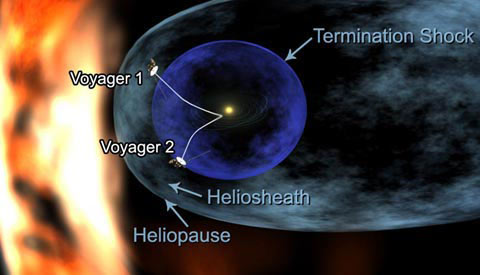Voyager Spacecraft Celebrate 30th Anniversary

NASA's twoVoyager spacecraft are celebrating three decades of flight as they careentoward interstellar space billions of miles from the solar system's edge.
Voyager 2launched on Aug. 20, 1977, and Voyager 1 launched on Sept. 5, 1977. Bothspacecraft continue to return information from distances more than three timesfarther away than Pluto, where the sun's outer heliosphere meets the boundaryof interstellar space.
"TheVoyager mission is a legend in the annals of space exploration. It opened oureyes to the scientific richness of the outer solar system, and it has pioneeredthe deepest exploration of the sun's domain ever conducted," said AlanStern, associate administrator for NASA's Science Mission Directorate,Washington, D.C. "It's a testament to Voyager's designers, builders andoperators that both spacecraft continue to deliver important findings more than25 years after their primary mission to Jupiter and Saturn concluded."
Voyager 1currently is the farthest human-made object at a distance from the sun of about9.7 billion miles (15.6 billion kilometers). Voyager 2 is about 7.8 billionmiles (12.6 billion kilometers).
Originallydesigned as a four-year mission to Jupiter and Saturn, the Voyager tours wereextended because of their successful achievements and a rare planetaryalignment. The two-planet mission eventually became a four-planet grand tour.After completing that extended mission, the two spacecraft began the task ofexploring the outer heliosphere.
Duringtheir first dozen years of flight, the spacecraft explored Jupiter, Saturn,Uranus, Neptune and their moons. These planets were previously unknown worlds.The Voyagers returned never-before-seen images and scientific data and helpedmake fundamental discoveries about the outer planets and their moons.
Thespacecraft revealed Jupiter's turbulent atmosphere, which includes dozens ofinteracting hurricane-like storm systems, and erupting volcanoes on Jupiter'smoon Io. They also showed waves and fine structure in Saturn's icy rings fromthe tugs of nearby moons.
Get the Space.com Newsletter
Breaking space news, the latest updates on rocket launches, skywatching events and more!
"TheVoyager mission has opened up oursolar system in a way not possible before the Space Age," said EdwardStone, Voyager project scientist at the California Institute of Technology,Pasadena, Calif. "It revealed our neighbors in the outer solar system andshowed us how much there is to learn and how diverse the bodies are that sharethe solar system with our own planet Earth."
In December2004, Voyager 1 began crossing the solar system's final frontier. Called theheliosheath, this turbulent area, approximately 8.7 billion miles from the sun,is where the solar wind slows as it crashes into the thin gas that fills thespace between stars. Voyager 2 could reach this boundary later this year,putting both Voyagers on their final leg towardinterstellar space.
Eachspacecraft carries five fully functioning science instruments that study thesolar wind, energetic particles, magnetic fields and radio waves as they cruisethrough this unexplored region of deep space. The spacecraft are too far fromthe sun to use solar power, and instead run on radioactive generators thatproduce less than 300 watts of power, the amount of power needed to light up abright light bulb..
"Thecontinued operation of these spacecraft and the flow of data to the scientistsis a testament to the skills and dedication of the small operations team,"said Ed Massey, Voyager project manager at NASA's Jet Propulsion Laboratory in Pasadena, Calif.
TheVoyagers call home via NASA's Deep Space Network, a system of antennas aroundthe world. The spacecraft are so distant that commands from Earth, traveling atlight speed, take 14 hours one-way to reach Voyager 1 and 12 hours to reachVoyager 2. Each Voyager logs approximately 1 million miles per day.
Each of theVoyagers carries a golden record that is a time capsule with greetings, imagesand sounds from Earth. The records also have directions on how to find Earth ifthe spacecraft is recovered by something or someone.
NASA's nextouter planet exploration mission is New Horizons, which is now well pastJupiter and headed for a historic exploration of the Pluto system in July 2015.
- Behind the Pictures: Top 10 Voyager Facts
- The Solar System Gets Crazier
- Is Voyager at the Solar System's Edge?
Join our Space Forums to keep talking space on the latest missions, night sky and more! And if you have a news tip, correction or comment, let us know at: community@space.com.

Space.com is the premier source of space exploration, innovation and astronomy news, chronicling (and celebrating) humanity's ongoing expansion across the final frontier. Originally founded in 1999, Space.com is, and always has been, the passion of writers and editors who are space fans and also trained journalists. Our current news team consists of Editor-in-Chief Tariq Malik; Editor Hanneke Weitering, Senior Space Writer Mike Wall; Senior Writer Meghan Bartels; Senior Writer Chelsea Gohd, Senior Writer Tereza Pultarova and Staff Writer Alexander Cox, focusing on e-commerce. Senior Producer Steve Spaleta oversees our space videos, with Diana Whitcroft as our Social Media Editor.









